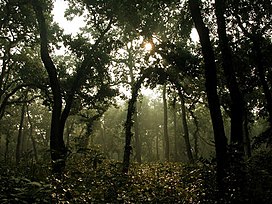Loading AI tools
From Wikipedia, the free encyclopedia
The Himalayan subtropical broadleaf forests is an ecoregion that extends from the middle hills of central Nepal through Darjeeling into Bhutan and also into the Indian States of Uttar Pradesh and Bihar. It represents the east–west-directed band of subtropical broadleaf forest at an altitude of between 500 and 1,000 m (1,600 and 3,300 ft) along the Outer Himalayan Range, and includes several forest types traversing an east to west moisture gradient.[2]
| Himalayan subtropical broadleaf forests | |
|---|---|
 Sal forest in Chitwan National Park | |
 Ecoregion territory (in purple) | |
| Ecology | |
| Realm | Indomalayan |
| Biome | tropical and subtropical moist broadleaf forests |
| Borders | |
| Bird species | 343[1] |
| Mammal species | 148[1] |
| Geography | |
| Area | 38,200 km2 (14,700 sq mi) |
| Countries | |
| Conservation | |
| Habitat loss | 81.553%[1] |
| Protected | 6.77%[1] |
The ecoregion covers an area of 38,200 km2 (14,700 sq mi) and is bisected by the Kali Gandaki River, which has gouged the world's deepest river valley through the Himalayan Range. It forms a critical link in the chain of interconnected Himalayan ecosystems, where altitudinal connectivity between the habitat types is important for ecosystem function. The soil is composed of alluvium deposited over the ages by the rivers that drain this young mountain range.[2]
At lower elevations, the ecoregion is flanked by the Terai-Duar savannas and grasslands. Above 1,000 m (3,300 ft), it yields to the Himalayan subtropical pine forests.
Rainfall varies from east to west, but annual rainfall can be as much as 2,000 mm (79 in). The Himalayas capture moisture from the monsoons that sweep in from the Bay of Bengal, and most of this rainfall is expended in the eastern Himalayas. Therefore, the western Himalayas are drier, a trend reflected in the timberline that declines from 4,000 m (13,000 ft) in the east to about 3,500 m (11,500 ft) in the west.[2]
The ecoregion hosts a broad range of plant communities, based on its complex topography, differing soils, and variations in rainfall from the drier west to the more humid east. Its location on the south slope of the Himalaya allows the intermingling of plants and animals from the Indomalayan and Palearctic biogeographic realms. The main forest types include Dodonaea scrub, subtropical dry evergreen forests of Olea europaea subsp. cuspidata, northern dry mixed deciduous forests, dry Siwalik sal (Shorea robusta) forests, moist mixed deciduous forests, subtropical broadleaf wet hill forests, northern tropical semi-evergreen forests, and northern tropical wet evergreen forests.
Several mammals native to the ecoregion are threatened, including the Bengal tiger, Indian elephant, smooth-coated otter, clouded leopard, gaur, Sumatran serow, Irrawaddy squirrel, and particoloured flying squirrel. The endemic golden langur is distributed in a small range and limited to the broadleaf forest north of the Brahmaputra River. The bird fauna is very rich with more than 340 species. The chestnut-breasted partridge is endemic; the globally threatened white-winged wood duck and five hornbill species are found here.[2]
Eight protected areas extend into this ecoregion covering 2,710 km2 (1,050 sq mi), which is about 7% of the ecoregion's area:[2]
Two high-priority tiger conservation units (TCU) extend across adjacent ecoregions:[3]
Seamless Wikipedia browsing. On steroids.
Every time you click a link to Wikipedia, Wiktionary or Wikiquote in your browser's search results, it will show the modern Wikiwand interface.
Wikiwand extension is a five stars, simple, with minimum permission required to keep your browsing private, safe and transparent.